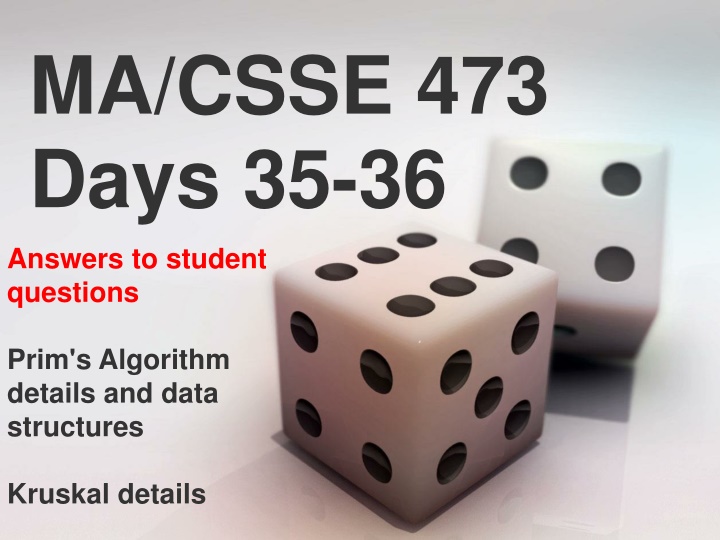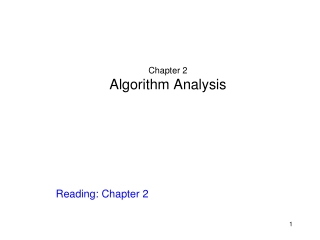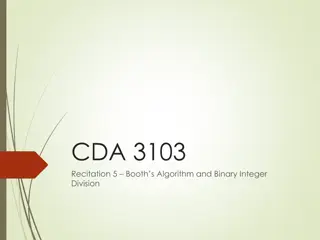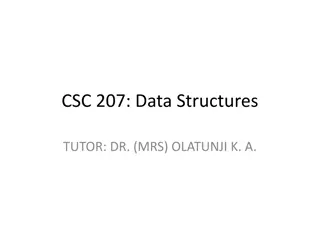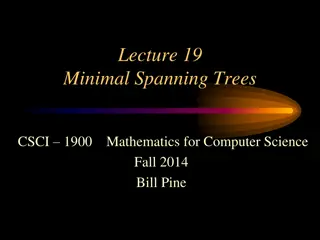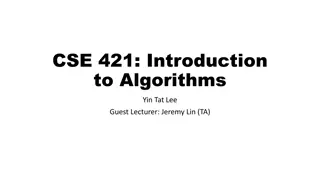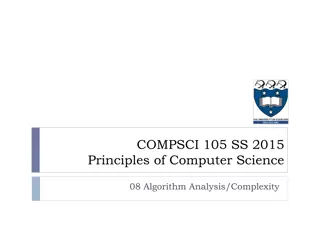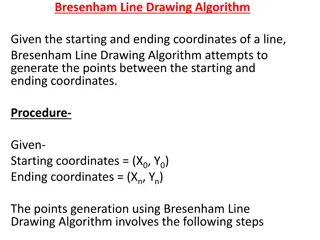Prim's Algorithm & Kruskal's Details and Data Structures
This content covers the detailed explanations of Prim's Algorithm and Kruskal's Algorithm, highlighting the intricacies of data structures involved in their implementation. Understand the nuances of these popular algorithms for solving graph problems effectively.
Download Presentation

Please find below an Image/Link to download the presentation.
The content on the website is provided AS IS for your information and personal use only. It may not be sold, licensed, or shared on other websites without obtaining consent from the author.If you encounter any issues during the download, it is possible that the publisher has removed the file from their server.
You are allowed to download the files provided on this website for personal or commercial use, subject to the condition that they are used lawfully. All files are the property of their respective owners.
The content on the website is provided AS IS for your information and personal use only. It may not be sold, licensed, or shared on other websites without obtaining consent from the author.
E N D
Presentation Transcript
MA/CSSE 473 Days 35-36 Answers to student questions Prim's Algorithm details and data structures Kruskal details
Kruskal Prim MST ALGORITHMS CONTINUED
Recap: Kruskals algorithm To find a MST: Start with a graph T containing all of G s n vertices and none of its edges. for i = 1 to n 1: Among all of G s edges that can be added without creating a cycle, add to T an edge that has minimal weight. Details later. We do Prim first.
Recap: Prims Algorithm for Minimal Spanning Tree Start with T as a single vertex of G (which is a MST for a single-node graph). for i = 1 to n 1: Among all edges of G that connect a vertex in T to a vertex that is not yet in T, add to T a minimum- weight edge. At each stage, T is a MST for a connected subgraph of G We now examine Prim more closely
Example of Prim s algorithm
Main Data Structures for Prim Start with adjacency-list representation of G Let V be all of the vertices of G, and let VT the subset consisting of the vertices that we have placed in the tree so far We need a way to keep track of "fringe" edges i.e. edges that have one vertex in VT and the other vertex in V VT Fringe edges need to be ordered by edge weight E.g., in a priority queue What is the most efficient way to implement a priority queue?
MinHeap overview We need an operation that a standard binary heap doesn't support: decrease(vertex, newWeight) Decreases the value associated with a heap element Instead of putting vertices and associated edge weights directly in the heap: Put them in an array called key[] Put references to them in the heap
MinHeap implementation An indirect heap. We keep the keys in place in an array, and use another array, "outof", to hold the positions of these keys within the heap. To make lookup faster, another array, "into" tells where to find an element in the heap. i = into[j] iff j = out of[i] Picture shows it for a maxHeap, but the idea is the same:
Min Heap methods operation description run time init(key) build a MinHeap from the array of keys (n) del() delete and return the (location in key[ ] of the) minimum element (log n) isIn(w) is vertex w currently in the heap? (1) keyVal(w) The weight associated with vertex w (minimum weight of an edge from that vertex to some adjacent vertex that is in the tree). changes the weight associated with vertex w to newWeight (which must be smaller than w's current weight) (1) decrease(w, newWeight) (log n)
MinHeap code part 1
MinHeap code part 2 NOTE: delete could be simpler, but I kept pointers to the deleted nodes around, to make it easy to implement heapsort later. N calls to delete() leave the outof array in indirect reverse sorted order.
Prim Algorithm Q7-10
Prim detailed algorithm summary Create a min-heap from the adjacency-list representation of G Each heap entry contains a vertex and its weight The vertices in the heap are those not yet in T Weight associated with each vertex v is the minimum weight of an edge that connects v to some vertex in T If there is no such edge, v's weight is infinite Initially all vertices except start are in heap, have infinite weight Vertices in the heap whose weights are not infinite are the fringe vertices Fringe vertices are candidates to be the next vertex (with its associated edge) added to the tree Loop: Delete min weight vertex from heap, add it to T We may then be able to decrease the weights associated with one or vertices that are adjacent to v
Data Structures for Kruskal A sorted list of edges (edge list, not adjacency list) Disjoint subsets of vertices, representing the connected components at each stage. Start with n subsets, each containing one vertex. End with one subset containing all vertices. Disjoint Set ADT has 3 operations: makeset(i): creates a singleton set containing i. findset(i): returns a "canonical" member of its subset. I.e., if i and j are elements of the same subset, findset(i) == findset(j) union(i, j): merges the subsets containing i and j into a single subset. Q37-1
Example of operations makeset (1) makeset (2) makeset (3) makeset (4) makeset (5) makeset (6) union(4, 6) union (1,3) union(4, 5) findset(2) findset(5) What are the sets after these operations?
Kruskal Algorithm What can we say about efficiency of this algorithm (in terms of |V| and |E|)? Assume vertices are numbered 1...n (n = |V|) Sort edge list by weight (increasing order) for i = 1..n: makeset(i) i, count, tree = 1, 0, [] while count < n-1: if findset(edgelist[i].v) != findset(edgelist[i].w): tree += [edgelist[i]] count += 1 union(edgelist[i].v, edgelist[i].w) i += 1 return tree
Set Representation Each disjoint set is a tree, with the "marked" element as its root Efficient representation of the trees: an array called parent parent[i] contains the index of i s parent. If i is a root, parent[i]=i 5 1 7 4 2 3 6 8 Q37-4
Using this representation makeset(i): findset(i): mergetrees(i,j): assume that i and j are the marked elements from different sets. union(i,j): assume that i and j are elements from different sets Q37-5
Analysis Assume that we are going to do n makeset operations followed by m union/find operations time for makeset? worst case time for findset? worst case time for union? Worst case for all m union/find operations? worst case for total? What if m < n? Write the formula to use min
Can we keep the trees from growing so fast? Make the shorter tree the child of the taller one What do we need to add to the representation? rewrite makeset, mergetrees findset & union are unchanged. What can we say about the maximum height of a k-node tree? Q37-5
Theorem: max height of a k-node tree T produced by these algorithms is lg k Base case Induction hypothesis Induction step: Let T be a k-node tree T is the union of two trees: T1 with k1 nodes and height h1 T2 with k2 nodes and height h2 What can we say about the heights of these trees? Case 1: h1 h2. Height of T is Case 2: h1=h2. WLOG Assume k1 k2. Then k2 k/2. Height of tree is 1 + h2 Q37-5
Worst-case running time Again, assume n makeset operations, followed by m union/find operations. If m > n If m < n
Speed it up a little more Path compression: Whenever we do a findset operation, change the parent pointer of each node that we pass through on the way to the root so that it now points directly to the root. Replace the height array by a rank array, since it now is only an upper bound for the height. Look at makeset, findset, mergetrees (on next slides)
Makeset This algorithm represents the set {i} as a one-node tree and initializes its rank to 0. def makeset3(i): parent[i] = i rank[i] = 0
Findset This algorithm returns the root of the tree to which i belongs and makes every node on the path from i to the root (except the root itself) a child of the root. def findset(i): root = i while root != parent[root]: root = parent[root] j = parent[i] while j != root: parent[i] = root i = j j = parent[i] return root
Mergetrees This algorithm receives as input the roots of two distinct trees and combines them by making the root of the tree of smaller rank a child of the other root. If the trees have the same rank, we arbitrarily make the root of the first tree a child of the other root. def mergetrees(i,j) : ifrank[i] < rank[j]: parent[i] = j elifrank[i] > rank[j]: parent[j] = i else: parent[i] = j rank[j] = rank[j] + 1
Analysis It's complicated! R.E. Tarjan proved (1975)*: Let t = m + n Worst case running time is (t (t, n)), where is a function with an extremely slow growth rate. Tarjan's : (t, n) 4 for all n 1019728 Thus the amortized time for each operation is essentially constant time. * According to Algorithms by R. Johnsonbaugh and M. Schaefer, 2004, Prentice-Hall, pages 160-161
